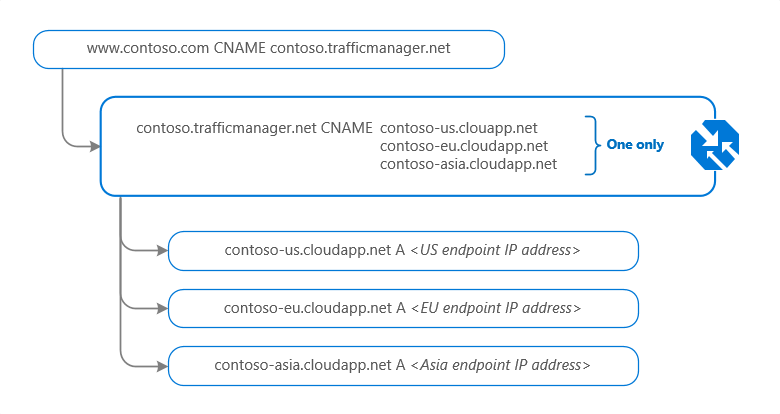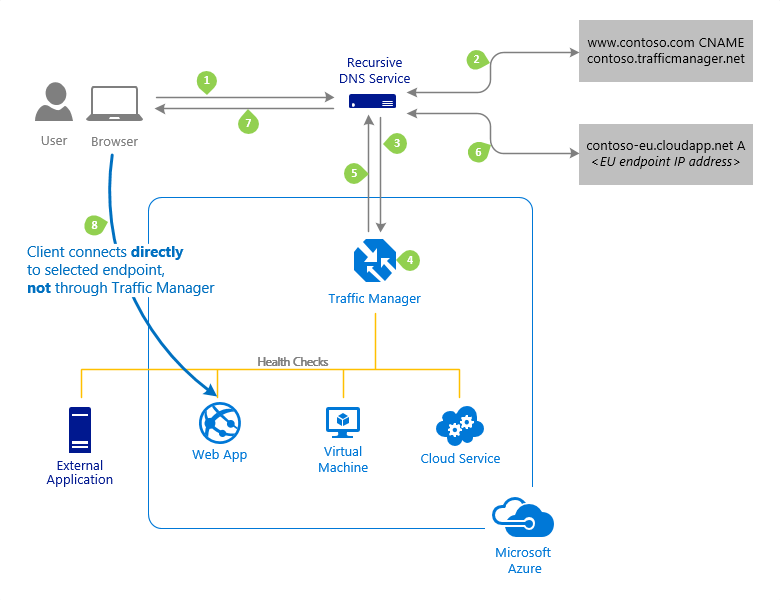Traffic Manager
Overview
Microsoft Azure Traffic Manager allows you to control the distribution of user traffic for service endpoints in different datacenters. Service endpoints supported by Traffic Manager include Azure VMs, Web Apps, and cloud services. You can also use Traffic Manager with external, non-Azure endpoints.
Traffic Manager uses the Domain Name System (DNS) to direct client requests to the most appropriate endpoint based on a traffic-routing method and the health of the endpoints. Traffic Manager provides a range of traffic-routing methods and endpoint monitoring options to suit different application needs and automatic failover models. Traffic Manager is resilient to failure, including the failure of an entire Azure region.
Benefits
Traffic Manager can help you:
-
Improve availability of critical applications
Traffic Manager delivers high availability for your applications by monitoring your endpoints and providing automatic failover when an endpoint goes down.
-
Improve responsiveness for high-performance applications
Azure allows you to run cloud services or websites in datacenters located around the world. Traffic Manager improves application responsiveness by directing traffic to the endpoint with the lowest network latency for the client.
-
Perform service maintenance without downtime
You can perform planned maintenance operations on your applications without downtime. Traffic Manager directs traffic to alternative endpoints while the maintenance is in progress.
-
Combine on-premises and Cloud-based applications
Traffic Manager supports external, non-Azure endpoints enabling it to be used with hybrid cloud and on-premises deployments, including the "burst-to-cloud," "migrate-to-cloud," and "failover-to-cloud" scenarios.
-
Distribute traffic for large, complex deployments
Using Nested traffic manager profiles, traffic-routing methods can be combined to create sophisticated and flexible rules to support the needs of larger, more complex deployments.
How Traffic Manager works
Azure Traffic Manager enables you to control the distribution of traffic across your application endpoints. An endpoint is any Internet-facing service hosted inside or outside of Azure.
Traffic Manager provides two key benefits:
- Distribution of traffic according to one of severalTraffic routing methods
- Endpoint monitoring and automatic failover when endpoints fail
When a client attempts to connect to a service, it must first resolve the DNS name of the service to an IP address. The client then connects to that IP address to access the service.
The most important point to understand is that Traffic Manager works at the DNS level. Traffic Manager uses DNS to direct clients to specific service endpoints based on the rules of the traffic-routing method. Clients connect to the selected endpoint directly. Traffic Manager is not a proxy or a gateway. Traffic Manager does not see the traffic passing between the client and the service.
Note
When using a vanity domain with Azure Traffic Manager, you must use a CNAME to point your vanity domain name to your Traffic Manager domain name. DNS standards do not allow you to create a CNAME at the 'apex' (or root) of a domain. Thus you cannot create a CNAME for 'contoso.com' (sometimes called a 'naked' domain). You can only create a CNAME for a domain under 'contoso.com', such as 'www.contoso.com'. To work around this limitation, we recommend using a simple HTTP redirect to direct requests for 'contoso.com' to an alternative name such as 'www.contoso.com'.
-
The chosen endpoint is returned as another DNS CNAME record. In this case, let us suppose contoso-us.cloudapp.net is returned.
- Next, the recursive DNS service finds the name servers for the 'cloudapp.net' domain. It contacts those name servers to request the 'contoso-us.cloudapp.net' DNS record. A DNS 'A' record containing the IP address of the US-based service endpoint is returned.
- The recursive DNS service consolidates the results and returns a single DNS response to the client.
- The client receives the DNS results and connects to the given IP address. The client connects to the application service endpoint directly, not through Traffic Manager. Since it is an HTTPS endpoint, the client performs the necessary SSL/TLS handshake, and then makes an HTTP GET request for the '/login.aspx' page.
The recursive DNS service caches the DNS responses it receives. The DNS resolver on the client device also caches the result. Caching enables subsequent DNS queries to be answered more quickly by using data from the cache rather than querying other name servers. The duration of the cache is determined by the 'time-to-live' (TTL) property of each DNS record. Shorter values result in faster cache expiry and thus more round-trips to the Traffic Manager name servers. Longer values mean that it can take longer to direct traffic away from a failed endpoint. Traffic Manager allows you to configure the TTL used in Traffic Manager DNS responses to be as low as 0 seconds and as high as 2,147,483,647 seconds (the maximum range compliant with RFC-1035), enabling you to choose the value that best balances the needs of your application.

